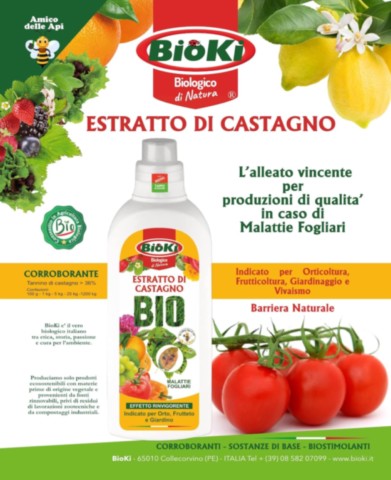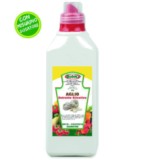Tannin extract
The tannin extract is obtained from a series of water extractions with exclusively physical processes, on high purity domestic chestnut wood (Castanea sativa), a very common phage in Europe, particularly in Italy and France. For production, only a selection of some trunks of old trees, generally 50-75 years old, appropriately seasoned, is used. It is also used in oenology to stabilize the color of wines, deactivate oxidizing enzymes, control bacterial development, precipitate proteins in solution. In plants it acts as an efficient elicitor capable of stimulating defense reactions and activating the development of natural substances against stress from biotic and abiotic adversities.
In this way, plants grow normally even in environmental conditions favorable to the development of fungi and bacteria. The product can be used in organic farming pursuant to EC Regulations 834/2007 and 889/2008.
DOSE AND METHOD OF USE:
Chestnut tannin can be used on all fruit, horticultural, floricultural and industrial crops, for foliar spraying and fertigation at every stage of development in open fields and in greenhouses.
Via the leaves it has an osmoprotective action where it is rapidly absorbed by the plant tissues and shows a very valid action for protection from frost both at the leaf and root level. Furthermore, it is a valid alternative to treatments with cupric products, as it creates an unfavorable environment for the development of cryptogams (downy mildew).
frost protection treatments 250-350g/hl, adding 600g of zeolite cliptolinolite to the mixture, treating the plant well without letting it drip. Protective treatments from fungal diseases: 300 g/hl, applying every 8-10 days
In fertigation, taking care to distribute the product in the last phase of the irrigation cycle to avoid losses due to leaching.
For complete protection of the crop, it is recommended to repeat the treatment 3-4 times during the vegetative cycle every 15-20 days with abundant volumes of water.
In this way, near the root system of the plants, the concentration of the product is kept constant and the development of fungi and the harmful action of nematodes is avoided. It is used at a dose of 1-3 kg/1000 m2 (equal to 10/30 kg/ha) every 8-10 days.
- Chestnut tannin forms a thin film on the vegetation which is very adhesive, nutritious, biodegradable, poorly permeable to oxygen, capable of reducing evapotranspiration during hot periods, reduces splitting of fruits, promotes healing, improves resistance to attacks of fungi and bacteria.
● The presence of polyphenols and organic acids allows us to improve the structure of the soil, acidify soils with excessive pH and reduce damage due to excess salinity. The polyphenolic component also stimulates the development of useful microflora (microbial antagonists) while limiting the proliferation of pathogens harmful to crops, contributes to limiting the development and multiplication of phytophagous nematodes responsible for alterations to the root system of plants thanks to the caustic action on juvenile forms and to the anti-feeding action on adult forms.
● The complexing properties of the tannin extract also promote the growth of the root system and the assimilation of nutritional elements useful for plants, especially in "tired" soils subject to fumigation and short rotations.
● Chestnut tannin can be used on vegetable, flower and fruit crops in an integrated and organic farming system using fertigation, distributing the product constantly during the development cycle of the crops.
At the root level, chestnut tannin creates a particularly favorable environment for the normal growth and development of the root system of plants (roots, tubers, taproots, etc.) even in the presence of soil parasites or other adverse biotic and abiotic factors. It improves the vitality of the soil and thanks to its acidic pH creates an environment inhospitable to nematodes.
PACKAGING: Offer n, 3 packs of 1 kg


You might also like....

Aglio EG
Flacone da 1 L
